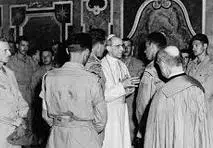In order to fully understand the meaning of the term concordat, it is necessary, first of all, to discover its etymological origin. In this case, we can state that it is a word that comes from Latin, exactly from the cultism "condordatum", which can be literally translated as "what is agreed upon in harmony." This Latin word derives from the verb “concordare”, which is the result of the sum of two clearly differentiated elements:
-The prefix “con-”, which means “together”.
-The noun “cor, cordis”, which is synonymous with “heart”.
A concordat is an agreement between a State and the Holy See that revolves around ecclesiastical issues .
 It should be noted that ecclesiastical is something related to the Church . The Holy See , for its part, refers to the government of the Roman Catholic Apostolic Church , which is based in Vatican City . A concordat, therefore, is an agreement signed by the authorities of a country and the leaders of the aforementioned Church.
It should be noted that ecclesiastical is something related to the Church . The Holy See , for its part, refers to the government of the Roman Catholic Apostolic Church , which is based in Vatican City . A concordat, therefore, is an agreement signed by the authorities of a country and the leaders of the aforementioned Church.
Concordats, at a legal level, are equivalent to international treaties . These agreements serve to regulate the links between the Holy See and the rest of the States in everything related to matters of common interest.
Most countries have established some concordat with the Holy See . Some concordats are very old, with several centuries of history, while others are much more recent.
The Concordat of Bologna , for example, is a pact signed by Pope Leo X and King Francis I of France in 1516 . This agreement established that the French monarch had the right to the tithe of the clerics and that the pope had the power to dispose of the income that the Catholic Church obtained in French territory , among other issues.
In 1753 , on the other hand, King Ferdinand VI of Spain and Pope Benedict XIV established a concordat that was signed in Rome . The alliance set out to end the conflicts linked to the so-called Patronato Regio .
However, with Spain there was another concordat. In 1953 was the year that occurred that sought to end the rupture between the country and the Holy See that took place during the Second Republic due to the secular policy that that government implemented.
After the Civil War and the establishment of the dictatorship of Francisco Franco, he sought to once again have a concordat with the aforementioned Holy See. It was not easy, as there were many meetings and meetings until an absolute agreement was reached. In this way, on August 27, 1953, the concordat was signed, which included aspects such as these:
-The State agreed to pay the expenses of the Church's activity.
-Franco had the possibility of taking part in the appointment of bishops through what was called the right of presentation.
-Among the privileges that were collected for the Church were some such as tax exemption for ecclesiastical assets and activities.
Closer in time , in 1986 , Bolivia established a concordat with the Holy See related to religious assistance provided to members of the National Police and the country's Armed Forces .
